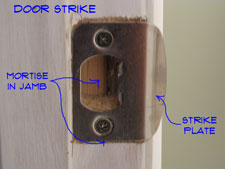 A strike plate that is mis-aligned can cause the door not to lock or close properly. Adjusting it can help.
A strike plate that is mis-aligned can cause the door not to lock or close properly. Adjusting it can help.
Not your problem? See 'Door Repair' for a complete listing of door topics. Door locks are discussed in depth in the article 'Door Lock Repair'. Use this link to get to that series of articles.
Fixing door locks and strikes are the main hardware issues for an interior door. Door locks need to align properly with the strike plates on the frame. Even a minor deviation can cause the door not to work.
The strike plates on the lock set can cause the door to bind. There are three ways that the strike plate can cause problems. (1) A door that is sagging will not allow the lock to properly align with the strike plate. When this is your problem you need to adjust the door. See the article 'Adjusting Interior Doors', for more information.
(2) The strike plate needs to be the proper distance from the door stop. A strike plate that is not close enough to the stop will leave the door loose in the opening. On the other hand, when the strike plate is too close the lock won't catch and the door won't stay closed. (3) The third problem is when the strike plate is binding against the door itself. This happens when the plate is not recessed into the frame.
Based on the above information, determine whether your door is too loose or if the latch isn't catching. When you have determined which way the strike plate needs to go you can move it. Measure the distance from the face of the door to the flat portion of the door lock tongue. See if the distance is different between the door stop and the flat section of the strike plate.
You can remove the strike plate and use a chisel to remove some wood from the mortise. The plate should be flush with the jamb and not protrude out. Strike plates should not be fastened on top of the jamb. They should be recessed in. Use a pencil to draw an outline around the strike plate. Remove it and use a chisel to cut out the wood to recess it.

